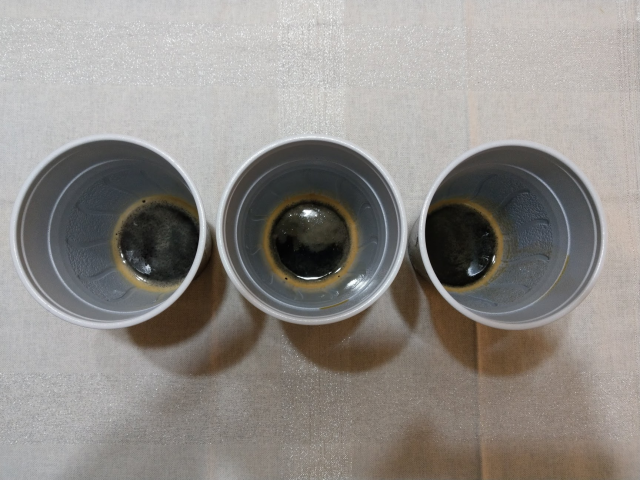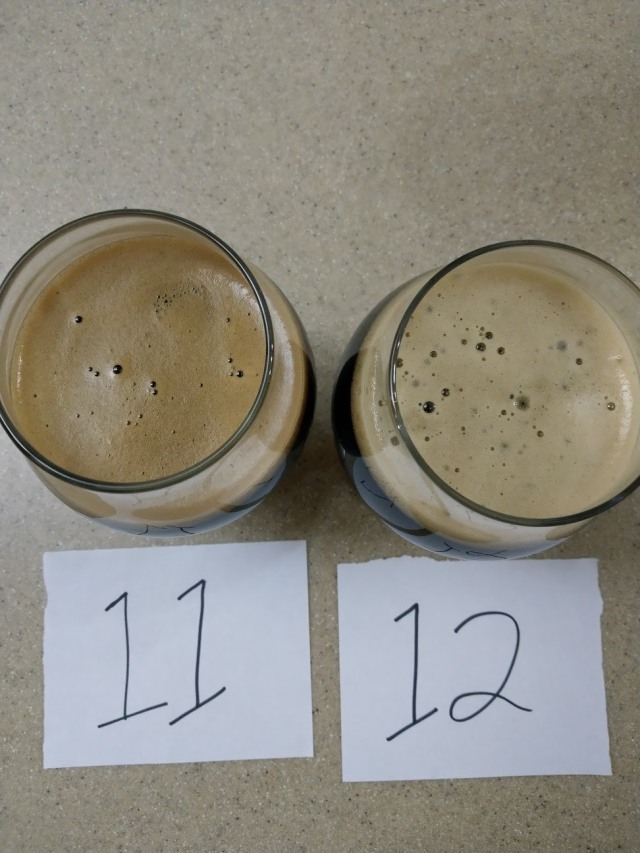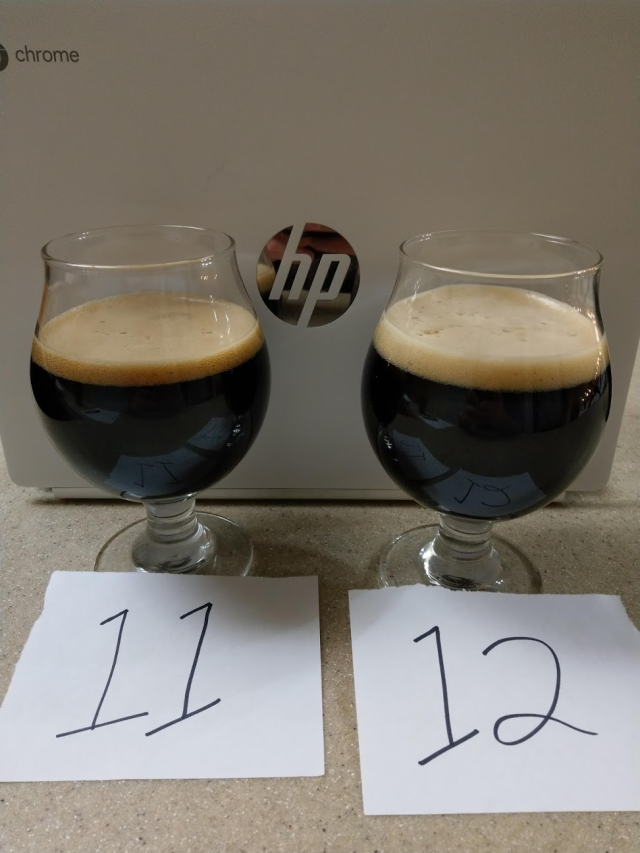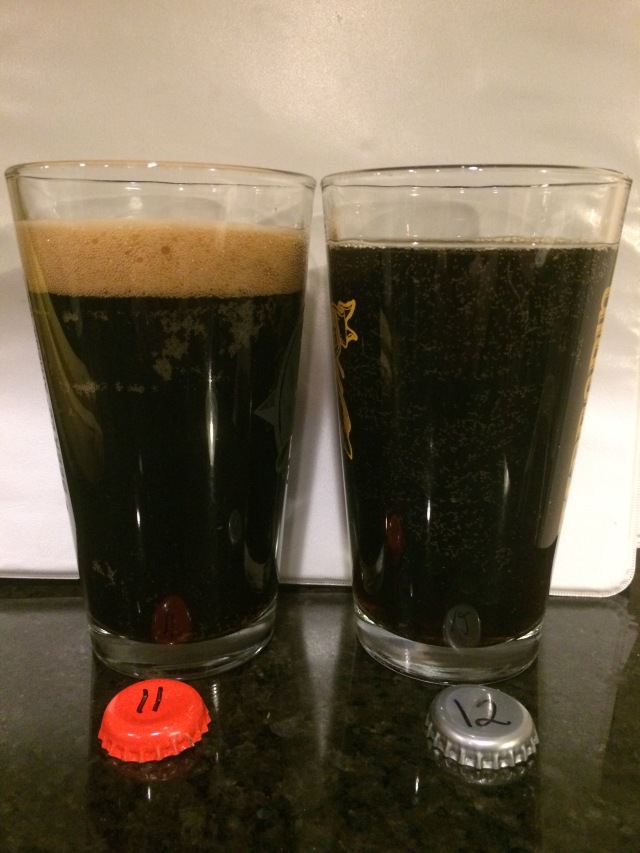This post is one in a series following six brewers collaborating to each make a small adjustment to a single recipe in order to improve it, then pass it along to the next brewer. We hope to learn more about the art of recipe creation as we see how other brewers approach the same recipe. The rest of the comparison tastings for this series can be found here.
The recipes for the beers being compared below are as follows:
| Iteration 11 | Iteration 12 | |
| Base Malt | 60.8% Maris Otter | 37.6% Maris Otter |
| Base Malt 2 | None | 15.1% 2-row |
| Specialty Malt 1 | 10.6% Victory | 11.3% Victory |
| Specialty Malt 2 | 7.8% Roasted Barley | 5.6% Roasted Barley |
| Specialty Malt 3 | 1.8% Chocolate Malt | 1.8% Chocolate Malt |
| Specialty Malt 4 | 7.8% Flaked Barley | 7.6% Flaked Barley |
| Specialty Malt 5 | 5.3% Pale Chocolate | 5.6% Pale Chocolate |
| Specialty Malt 6 | None | 9.4% Flaked Oats |
| Sugar | 6% Corn Sugar | 6% Corn Sugar |
| 60 min. hop | Nugget: 42.9 IBUs | 43 IBUs |
| 5 min. hop | Centennial: 6.7 IBUs | 6.7 IBUs |
| Yeast | WYeast 1450 Denny’s Favorite 50 | WYeast 1450 Denny’s Favorite 50 |
| OG | 1.064 | 1.062 |
| FG | 1.021 | 1.016 |
| ABV | 5.8% | 6.1% |
Taster: M. Rasmussen
Just like last time, my brewing partner and I set up a blind triangle test for ourselves before we began the real comparison tasting. I poured two samples of each beer in opaque cups and marked the bottom of the cups with a sharpie. I mixed up the cups and placed them on a shelf so that my partner (later referred to as J) could select 3 cups completely blind to what was in them. We were actually able to identify the odd one out based off of the color of the foam. Surprisingly, the aroma of the beers were quite similar, but the taste matched the stark difference in appearance. It was a very easy triangle test, and we’re two for two on our triangle tests with this stout project.

Appearance: Iteration 11 poured just as I remembered: opaque black with a thin, dark tan head. My partner, J, pointed out that it’s very reminiscent of Russian imperial stout, which was a common theme for this tasting. There was slightly more carbonation than Iteration 12, and head retention was moderate. There was very minimal lacing on the glass as we drank. M prefers number 11.
Iteration 12 looked almost identical to its predecessor in the glass, except for the off-white head. The thin ring of foam that lingered was similar to an Irish Dry stout. There was decent head retention and some mild lacing on the glass as we drank. J prefers number 12.

Aroma: The biggest aroma to me on Iteration 11 was a strong dark chocolate covered cherry. I also got slight hints of plum and alcohol. When the beer was cold, there was a hint of nuttiness that’s closest to hazelnut. As the beer warmed up to around 50℉, that hint of nuttiness became a rich, chocolatey hazelnut character. The aroma was also very roast forward. J prefers number 11.
The main aroma in this beer was roasted grains. When the beer was cold, the roasted aroma was also slightly burnt smelling. There was a hazelnut smell here that became more expressive as the beer warmed. There was also a bit of fruitiness, but lighter than Iteration 11. We weren’t exactly sure which fruit was most representative, so we’re calling it “plum light”—not as strong as the plum character in Iteration 11, but it was close. M prefers number 12.
Taste: Iteration 11’s flavor is best described with the word ‘roast’. There was quite a lot less fruitiness to the flavor profile than there was in the aroma. The fruity flavor that was there was closer to plum than the dark cherry I was smelling. The burnt, bitter, overpowering roastiness I remembered from my first tasting was still there. Other descriptors that were mentioned included “not pleasant” and “astringent.” Then we noticed that if you hold a swig in your mouth, let it sit, and warm up, it developed into a richer, more complex flavor profile. I got back some of the strong, cherry fruitiness that I missed from the aroma. Once the beer had reached 55℉, the flavor profile became much more balanced.
There was a medley of hazelnut, roast, and chocolate for the major flavor profile in Iteration 12. There was the slightest bit of fruitiness in the middle of the swallow as well. The roastiness was strong, but less subtle and more pleasant compared to Iteration 11. M & J prefer number 12.

Mouthfeel: Although there was a heavy thickness to the mouthfeel, it still felt fluffy and pillowy on the tongue. There was a low amount of carbonation, but I could feel some light bubbling on the tip of the tongue. J prefers number 11.
The mouthfeel in Iteration 12 was quite thin, but still fluffy and pillowy on the tongue. The light amount of carbonation bubbled on the tongue. M prefers number 12.
Aftertaste: There was a slight character in the finish to Iteration 11 that wasn’t apparent in the main flavor profile. Something showed up after swallowing that gave it a more pleasant, bitter chocolate flavor that lingered.
In Iteration 12, there was a creamy, roasty character that lingered after the swallow. J and I were throwing out a litany of phrases while we tried to place a firm description on the aftertaste of Iteration 12. Hazelnut, coffee liqueur, espresso & baileys, spiked coffee, and amaretto were all mentioned. I’m still not quite sure which of those are most accurate, as they all seem to describe the flavor that this beer left on the palate after it was gone. M & J prefer number 12.
Overall: After completing this tasting, I realized that I rushed through my first tasting of Iteration 11. I didn’t allow the beer to warm up at all, so it didn’t have the chance to develop into the stout it truly was: a mock imperial-style stout. The heavy mouthfeel, complex profile, strong fruit, and roast character all combined to form a beer that was extremely reminiscent of a Russian Imperial Stout. I’m not sure how or why, since the ABV was only 5.8% and the focus of this project was to brew a plain stout. That being said, once this beer warmed up, it was a very pleasant experience. Each sip was slightly different than the last. I’ve come around from thinking this beer was a bitter mess, to realizing it was a very complex stout that ultimately just didn’t match my personal preference for the style.
The easiest way to describe Iteration 12 is that it was an Irish-like stout. The off-white head, thinner mouthfeel, and creamy aftertaste were all very similar to what one would expect from a glass of Guinness or Murphy’s. Compared to Iteration 11, this beer seemed more balanced and easy-drinking. I still think this was the best stout I’ve brewed, and I will definitely be brewing it again. M & J prefer number 12.
Taster: C. McKenzie
Iteration 11 was a deep black and poured with a thick, tan head that had excellent retention. Iteration 12 was also black, but definitely lighter in color and almost a super-dark brown when held to the light. This beer also had a minimal off-white head with mild retention, though I suspect this was due to the lack of carbonation in the bottle (likely caused by bottling from the keg).

The aroma of Iteration 11 was one of chocolate and espresso (reminiscent of mocha), toast, and roasted character. There was also a mild citrus aroma from the hops. Iteration 12 had notes of roast, toast, coffee, and dark chocolate. There was a distinct character compared to 11 that I can only describe as “smelling lighter.”
The flavor of Iteration 11 had a prominent cherry character that was complemented by chocolate notes and roast. All of this faded into a bitterness that stuck around for a little while but didn’t linger too long. This beer was like biting into a dark chocolate bar, with those dark fruit flavors that often accompany dark chocolate that is at least 70% cacao. Iteration 12’s flavor was one of roasted character and coffee. Again, as in the aroma, there was a character that I described as “lighter”—there was almost a brown ale-like quality to it. It tasted like more than a brown ale and was definitely a stout, but something about the character was reminiscent of a brown ale to me—this beer was almost like the older brother of a brown ale. Perhaps it was the lower carbonation levels calling English ales to mind that caused me to perceive the beer this way, but to clarify, I certainly wouldn’t mistake this for a brown ale if I were given the beer blind. Again, it definitely had proper stout character, but something about the change between the recipes of 11 and 12 made this beer feel lighter in character.
Overall, these beers are quite different. I imagine if I were given these beers blind side by side that I would never have considered that they were so close in recipe. In fact, even knowing the recipes of each while tasting them, they still tasted like very different beers. Both beers were quite good, and I would gladly drink either, but what little difference there was between them in the recipes actually ended up creating a rather stark difference.
